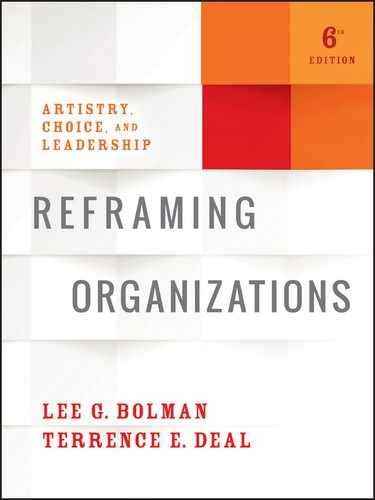Part Five
The Symbolic Frame
When the Catholic Church changed the liturgy from Latin to English many parishioners rebelled even though the change made sacred tenets more accessible. For many it was the first time that they could grasp and grapple with the sacred values of their faith. In Hunger of Memory, one parishioner describes vividly his reaction to the change:
But now that I no longer live as a Catholic in a Catholic world, I cannot expect the liturgy—which reflects and cultivates my faith—to remain what it was. I will continue to go to the English mass. I will go because it is my liturgy. I will, however, often recall with nostalgia the faith I have lost…The church is no longer mine (Rodriguez, 1997, p. 107).
In 1995 The Coca-Cola Company changed its 99-year-old recipe for its flagship soft drink. Pepsi, the company's chief competitor, was making inroads into Coke's market share; and in a series of blind taste tests, the new recipe was consistently preferred over Pepsi. This gave the company executives confidence that a new product would corner the market. The New Coke was launched with an elaborate advertising campaign.
Public reaction was swift and unanticipated. Some consumers filled their basements with the original Coke. Protest groups popped up across the country. Songs were written to honor the old taste. Protestors at an event in Atlanta carried placards: “We want the real thing,” “Our children will never know refreshment.” Other reactions carried the same sentiment.
Both the Latin liturgy and Coca-Cola are laden with symbolism. Symbols carry powerful intellectual and emotional messages; they speak to the heart and the soul. They are embedded in myths which are truer than true. “It is through myths that men are lifted above their capacity in the ordinary, attain powerful visions of the future, and realize such visions” (Berger, 1974, p. 26).
The symbolic frame focuses on how myth and symbols help humans make sense of the chaotic, ambiguous world in which they live. Meaning, belief, and faith are its central concerns. Meaning is not given to us; we create it. There are, for example, many who revere the American flag and many others who burn it. The flag is symbolically powerful for both groups but for different reasons. It represents patriotism for one group, oppression or imperialism for the other. Symbols are the basic materials of the meaning systems, or cultures, we inhabit. Leaders are bricoleurs, people who survey and use the materials at hand to help construct meaning systems. We experience our way of life in the same way that fish live in water. Many contemporary leaders highlight the critical role culture plays in organizations:
- Lou Gerstner (IBM): “I came to see, in my time at IBM, that culture is not just one aspect of the game—it is the game.”
- Peter Drucker: “Culture eats strategy for breakfast.”
- Jim Sinegal (Costco): “What else have we got besides stories? It's what brings meaning to the work we do.”
- Howard Schultz (Starbucks): “A company can grow big without losing the passion and personality that built it, but only if it's driven not by profits but by values and people.”
- John Mackey (Whole Foods): “Culture is no less than ‘how we do things around here.’ Less tangible than other physical assets on a company balance sheet, it is nonetheless the most valuable asset a company has—for it stitches people together in common beliefs, values and purpose and represents the basis for authenticity of experience for both team members and customers.”
Chapter 12 explores the many forms cultural symbols take in social life, including myth, vision, story, heroes and heroines, ritual, and ceremony. It then uses a variety of examples to demonstrate what culture is and why it is so important.
In Chapter 13, we apply symbolic concepts to team dynamics. We use a detailed case of a legendary and highly successful computer development team to show that the essence of its success was cultural and spiritual. The team relied on initiation rituals, humor, play, specialized language, ceremony, and other symbolic forms to weld a diverse and fractious group of individuals into a spirited, successful team.
Chapter 14 highlights dramaturgical and institutional perspectives, viewing organizations as akin to theater companies seeking recognition and support by staging dramas that both please and influence their audiences. We show that many activities and processes in organizations—such as evaluation and strategic planning—rarely achieve their supposed goals. Yet they persist, because they convey vital symbolic messages that internal and external audiences yearn for.
